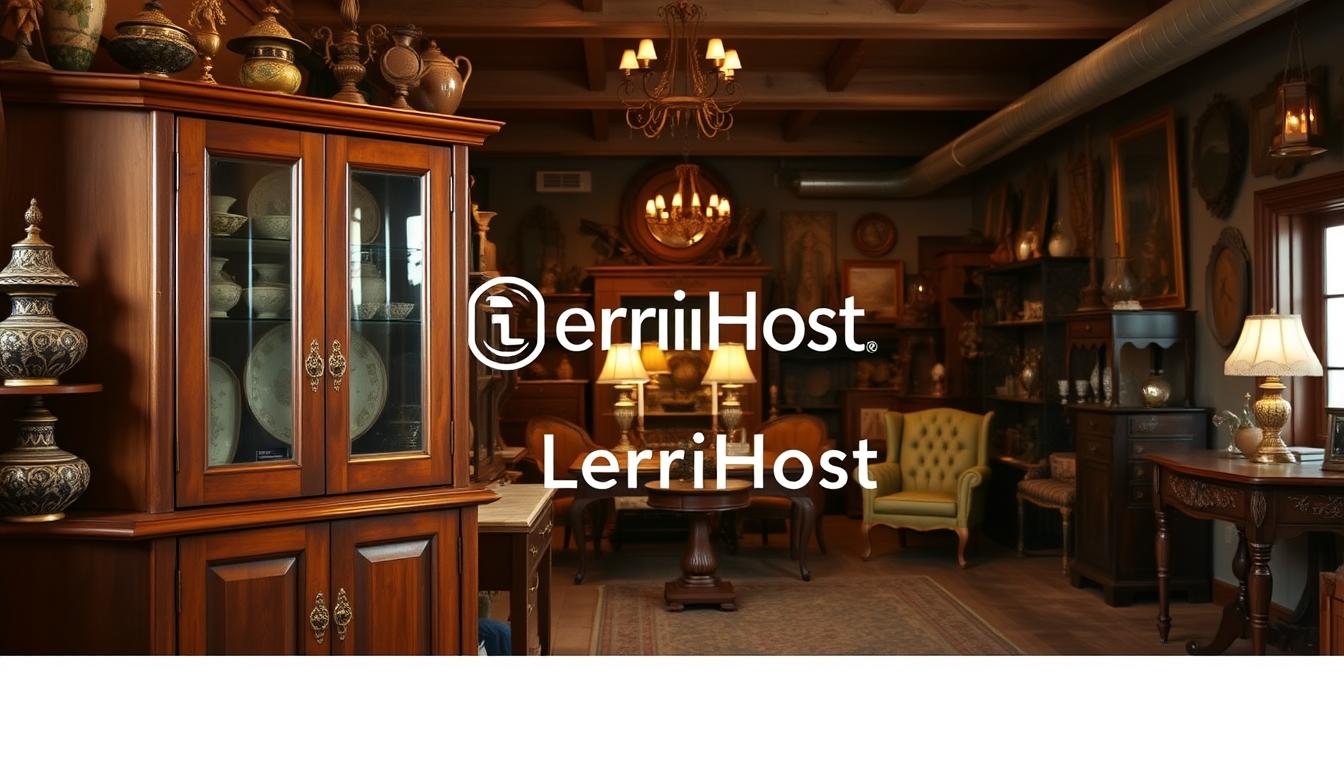Starting an antique business in Norway is an exciting venture. The antique market in Norway is rich and diverse. It combines cultural heritage with skilled craftsmanship, making it a great choice for entrepreneurs.
As we dive into launching our antique business, we need to look at the market and our love for antiques. By studying current trends and what local collectors like, we can find a special spot in the market. This spot will show our love for history and meet our business aims.
Understanding the Antique Market in Norway
Getting to know the antique market is key for our business. We’ll look into the trends in Norway, focusing on what collectors and fans love. This helps us match what we sell with what buyers want. Things like old furniture, traditional crafts, and collectibles are big hits, thanks to their history.
We want to please both local collectors and visitors. They’re all looking to find the beauty in Norway’s antiques.
Key Trends and Popular Items
The Norway antiques world has some big trends we need to follow. Here’s a table showing the top categories and what makes them special:
| Item Category | Popular Types | Characteristics |
|---|---|---|
| Furniture | Mid-century modern, rustic | Unique craftsmanship, timeless design |
| Traditional Crafts | Handmade items, textiles | Cultural significance, artisanal quality |
| Collectibles | Postcards, coins | Historical value, nostalgia |
Potential Customers and Demographics
Knowing who might buy our antiques is important. Our customers could be:
- Local collectors wanting unique pieces for their collections.
- Tourists after real souvenirs that show off Norwegian culture.
- Interior designers searching for special items to decorate homes.
By understanding what they like and how they shop, we can make our offerings and marketing better. This way, we can really connect with our audience.
Legal Requirements for Starting an Antique Business
Starting an antique business is complex. We must get the right permits and follow Norway’s business rules. This is key to avoid legal issues later on.
Necessary Licenses and Permits
We first need to register with the Brønnøysund Register Centre. This gives us legal permission to do business in Norway. Depending on what we sell, we might need more permits. Knowing the local rules helps us stay on the right path.
Import Regulations for Antiques
Buying antiques from abroad can grow our collection. But, we must follow strict import laws. Not following customs rules can result in big fines or losing our goods. We also need to respect heritage laws to protect cultural items while running our business.
Sourcing Antiques: Where to Find Your Inventory
Finding quality antiques is key to building our inventory. We can look at many places to find them, like local auctions and estate sales. These places let us see unique items and meet other collectors.
Online antique marketplaces are also great. They offer a wide range of rare finds and help us understand prices.
Local Auctions and Estate Sales
Local auctions are full of treasures. They have items from all eras, giving us a chance to see many different things. Estate sales are similar, showing personal items that might be valuable.
Going to these sales not only grows our collection. It also helps us meet other collectors and dealers in the area.
Online Marketplaces and Resources
In today’s world, online antique marketplaces like eBay and Etsy are essential. They have a huge variety of items, both local and from around the world. We can keep an eye on these sites to spot trends and find rare antiques.
Working with local collectors who use these sites can help us find valuable pieces. These pieces will likely interest our target audience.
Establishing Your Brand Identity
Creating a unique brand identity is key for our antique business. It draws in customers and builds loyalty in a crowded market. A well-chosen business name is essential; it must connect with our audience and show what we offer.
Choosing a Business Name
Finding a great business name is a mix of creativity and planning. It should bring back memories, suggest our specialty, and be simple to recall. We need to check for trademarks, domain names, and cultural meanings. A catchy name is the base for our branding and marketing.
Designing Your Logo and Marketing Materials
Our logo is the face of our brand. When designing it, we aim to reflect our values and grab customer attention. Being consistent in all marketing, like cards and brochures, is important. It shows we are professional and builds trust with our audience.
Setting Up Your Retail Space
The layout and location of our retail space are key to customer engagement. Picking the right spot for our antique store can boost foot traffic and browsing. We should look for areas with historical significance or popular shopping spots. These places attract people searching for unique items.
Ideal Locations for an Antique Store
Finding the perfect spot is essential for our success. Here are some top areas to think about:
- Historic districts with a rich architectural heritage.
- Shopping areas frequented by tourists and locals alike.
- Nearby art galleries or artisan markets to tap into a creative community.
- Locations near cafés and restaurants that draw in foot traffic.
Creating an Inviting Atmosphere
The design and feel of our store are critical for welcoming shoppers. Key elements include:
- Warm, welcoming lighting that highlights featured items.
- Clear signage that guides customers through our collections.
- Thoughtful display techniques that showcase antiques attractively.
- Comfortable seating areas that encourage customers to linger.
By combining the perfect location with a welcoming atmosphere, we can improve the shopping experience. This will attract both collectors and casual shoppers.
| Location Type | Advantages | Considerations |
|---|---|---|
| Historic Districts | Attracts history enthusiasts and tourists | Higher rental costs |
| Shopping Areas | Increased foot traffic year-round | Potential competition from other businesses |
| Art Galleries | Draws creative clientele | May require niche marketing strategies |
| Cafés and Restaurants | Captive audience; encourages browsing | Dependence on nearby dining traffic |
Pricing Your Antiques Effectively
Setting the right price for our antiques is key to their success. It’s important to understand how to value them. We need to look at their worth and condition carefully. This helps us set prices that make sense.
Assessing Value and Condition
Valuing antiques means checking each piece closely. Things like age, history, and condition affect the price. Looking at resources like The Antique Roadshow or talking to experts from The International Society of Appraisers helps a lot. We should focus on:
- Authenticity: A real antique is more valuable.
- Condition: Items in good shape are worth more than those that need fixing.
- Market Demand: What buyers want can change, affecting prices.
Strategies for Competitive Pricing
Good pricing is essential. We can make our antiques more appealing with discounts or special offers. Knowing our market and comparing with others helps us stay competitive. Important strategies include:
- Looking at what similar items have sold for to set prices.
- Using discounts during busy times.
- Running deals for new or loyal customers.
By using these strategies, we can make more money and attract more customers.
| Factor | Impact on Value |
|---|---|
| Age | Older items often have higher value due to rarity. |
| Condition | Excellent condition can significantly increase value. |
| Market Demand | High demand can justify a higher price. |
| Provenance | Documented history enhances perceived value. |
Building an Online Presence
In today’s world, having a strong online presence for antiques is key for any antique business. A well-made website is like a foundation, showing off our special items and telling our brand’s story. It’s the first place customers see us, so it must be engaging and easy to use.
Creating a Website for Your Antique Business
When making our website, we need to focus on a few things. High-quality images of our antiques grab visitors’ attention. Detailed descriptions that share each item’s history make them more appealing and encourage buying.
An easy-to-use site lets customers browse without hassle. And, making sure it works well on mobile devices is important. We also need a blog to share our knowledge and keep up with antique trends, boosting our online presence.
Utilizing Social Media for Engagement
Social media is also vital for reaching and engaging with customers. On platforms like Instagram and Facebook, we can show off new items, special finds, and customer feedback. By posting regularly, we keep our audience interested and coming back for more.
Using interactive posts, like polls or questions, helps build a community around our business. It lets us connect more with our followers.
Marketing Strategies for Antique Businesses
Effective marketing is key to our antique business’s success. We find great success in promoting our brand at local events like flea markets and workshops. These events help us connect with the community and showcase our unique items.
By attending these events, we reach new customers and build trust. This leads to loyal customers who appreciate our antiques.
Promoting Through Local Events and Markets
Local events are a great way to show off our antiques. Flea markets and fairs attract people looking for special items. Here, we can share the history and stories behind our pieces.
This personal touch makes buyers more likely to buy from us. It also encourages them to tell others about our antiques.
Collaboration with Interior Designers
Working with interior designers is another smart strategy. They help us reach clients who want unique decor. Designers often look for special items to add to their projects.
By teaming up with designers, we gain credibility and visibility. We can offer discounts for designers who recommend our items. This benefits both parties and boosts our brand.
Customer Service in the Antique Business
Exceptional customer service is key in our antique business. We know that a great shopping experience can make customers come back. We focus on clear communication, knowing our products well, and being friendly.
Starting a strong customer service plan means making customers feel special. We tailor our service to meet their needs. This could be through personal recommendations or just listening to what they want. It builds a strong bond with our customers.
Importance of Creating a Positive Experience
It’s not just about selling; it’s about building relationships. Customers love it when we go the extra mile. A simple thank-you note or a cup of coffee can make a big difference.
These small acts help us keep customers coming back. They turn first-time visitors into regulars.
Handling Returns and Complaints
We aim to provide top-notch service, but we also have a clear returns policy. Being open about our returns policy helps customers know what to expect. If they’re not happy, we listen and act fast.
This shows we care about their satisfaction. It keeps their trust in us.
Networking with Other Antique Dealers
Networking is key for antique dealers to grow their businesses. Joining industry associations opens doors to many resources and support. These groups help us work together on projects that boost our market presence.
Trade shows and conferences are also vital. They let us show off our antiques and keep up with trends. These events are great for meeting new clients and learning from experts.
Joining Local and National Associations
Being part of local and national associations has big benefits. They offer:
- Exclusive market reports and trends
- Networking events for antique pros
- Credentialing and educational tools
Being part of these groups makes us more knowledgeable and respected in the antique world.
Attending Trade Shows and Conferences
Trade shows and conferences are key for meeting other dealers. At these events, we can:
- Find new products and services
- Learn from workshops and seminars
- Show our antiques to more people
These events are perfect for learning and working together. They help us stay competitive in the market.
Expanding Your Business: Future Opportunities
As we grow our antique business, looking for new chances is key. We need to add items that show off the latest trends and collectibles. This way, we can draw more customers and make our business stronger.
Also, we should think about selling more online. Having a strong online presence lets us reach people all over the world. This helps us stay visible and keeps up with the shift to online shopping.
By mixing up our stock and selling more online, we’re set for success. Being flexible and meeting market needs will help our business grow and succeed in the competitive world of antiques.







